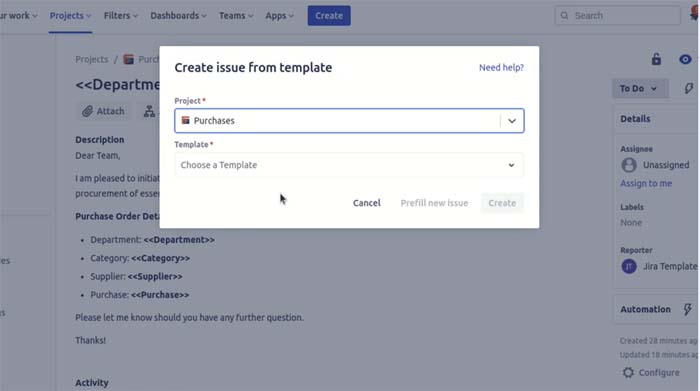In the fast-paced world of project management, efficiency is critical. And when it comes to managing tasks and workflows, Jira has been a go-to tool for many organizations.
With its robust features and flexibility, Jira allows teams to streamline processes, track issues, and collaborate effectively.
One of the standout features that enhances Jira’s efficiency is its issue templates. This comprehensive guide will delve into Jira templates, exploring what they are, why they matter, and how to create and use them effectively.
Issue templates for Jira come with practical value, delivering you a decent working experience over here. All these things are productive and ensure a decent working experience.
Introduction of Jira Templates
In Jira, templates are pre-defined structures for various types of issues that your team commonly encounters. These templates help standardize and streamline the creation of issues, ensuring consistency across projects and teams.
They serve as a starting point, allowing you to define the necessary fields, workflows, and customizations for different issue types.
Jira Templates can deliver you effective properties and supreme quality technical presence. If you want to get all the idealistic experience or other things, you can surely go with any Jira templates.
Why Are Jira Templates Important?
Jira Template comes with multiple importance. All these things are impressive and ensure you have an idealistic experience if you want the best technical experience with others here.
- Consistency: Templates ensure that similar issues are created consistently, reducing errors and misunderstandings within your team. To get working consistency over here, explore all these Jira Templates.
- Time Efficiency: By providing predefined fields and workflows, templates save time when creating issues, as users don’t have to configure everything from scratch. You can use this Jira Template to get all the idealistic technical experience with others.
- Customization: Templates are flexible and can be customized to suit your team’s specific needs, making them adaptable to various project requirements. It’s pretty handy to customize all the productive properties of this template.
- Standardization: They promote best practices and standardization across projects, fostering a more organized and efficient work environment. Just get all the standard facilities or others over here without any issues.
Types of Jira Templates: Explore all the Categories of the Jira Templates: Issue templates for Jira
Jira provides various templates to cater to different needs and project requirements. Let’s explore some of the most commonly used ones;
- Story Templates: Story templates are essential in Agile methodologies like Scrum. They help define user stories, including the user’s perspective, acceptance criteria, and story priority. These templates are crucial for breaking down larger tasks into manageable units. This story template will help you in getting all the decent working preferences.
- Epic Templates: Epics are used to group related user stories or tasks. Epic templates allow you to outline the epic’s goals, scope, and dependencies, providing a high-level view of project progress. If you want to get all the idealistic epic template experience, then
- Custom Templates: Custom templates offer the most flexibility. You can create templates tailored to your specific project’s needs, including any combination of fields and workflows that align with your team’s unique requirements.
- Task Templates: Task templates are designed for simple, individual tasks. They typically include fields for a summary, description, assignee, priority, and due date. Task templates are excellent for managing everyday work items efficiently. If you like to maintain some tasks or other technical things, then exploring the Jira template will deliver a decent working preference over here.
- Bug Templates: Bug template in Jira are tailored to track and resolve software bugs. They usually include fields for a detailed bug description, steps to reproduce the bug, severity level, and the affected component or software version.
Facilities of the Jira Templates: Issue templates for Jira
Jira Templates will deliver you with all the ideological and technical expertise. If you want to unlock all the remarkable facilities, you can surely go with all these Jira templates over here.
- Accessing Template Management: To create templates in Jira, you must have administrator or project administrator rights. Once you have the necessary permissions, navigate to the template management section within Jira.
- Creating a New Template: In the template management section, you’ll find an option to create a new template. Choose the type of template you want to create and begin defining the fields, workflows, and customizations according to your project’s needs.
- Customizing Fields and Workflows: Customization is where the true power of Jira templates shines. You can add, edit, or remove fields to capture the specific information your team requires. Additionally, you can define workflows, transitions, and automation rules to streamline the issue’s lifecycle.
- Customizing Templates as Needed: While templates provide a structured starting point, don’t hesitate to customize them further as your project evolves. Requirements change, and your templates should adapt to meet new challenges and objectives.
- Training and Documentation: To ensure that everyone on your team knows how to use Jira templates, provide training and create documentation. This proactive approach will help prevent errors and improve overall productivity.
Advanced Tips and Tricks of Jira Templates
Now that you have a solid understanding of Jira templates and how to use them effectively let’s explore some advanced tips and tricks to take your template management to the next level.
- Template Validation Rules: Using templates, you can enforce specific rules and validations. For example, you can require specific fields to be filled out before an issue can be created, ensuring that essential information is never overlooked.
- Template Automation: Leverage automation rules to streamline your workflows even further. For instance, you can automatically assign issues to specific team members based on their content or status, reducing manual intervention and speeding up task allocation.
- Template Integration: Integrate Jira templates with other tools your team uses, such as Confluence or Slack, to improve communication and collaboration. These integrations can enhance your team’s efficiency by centralizing information and reducing context switching.
- Version Control for Templates: Implement version control for your templates to track changes and ensure everyone uses the latest version. This helps prevent issues arising from using outdated templates, ensuring project consistency.
Conclusion
Jira templates are a potent tool for enhancing your organization’s consistency, productivity, and collaboration. By understanding their types, creating custom templates, and using them effectively, you can streamline your project management processes and stay ahead in today’s fast-paced work environment.
We have provided you with the best-ever guide over the Jira Templates. If you have any queries, inform us via the comment box. Thanks for reading this article!







Leave a Reply